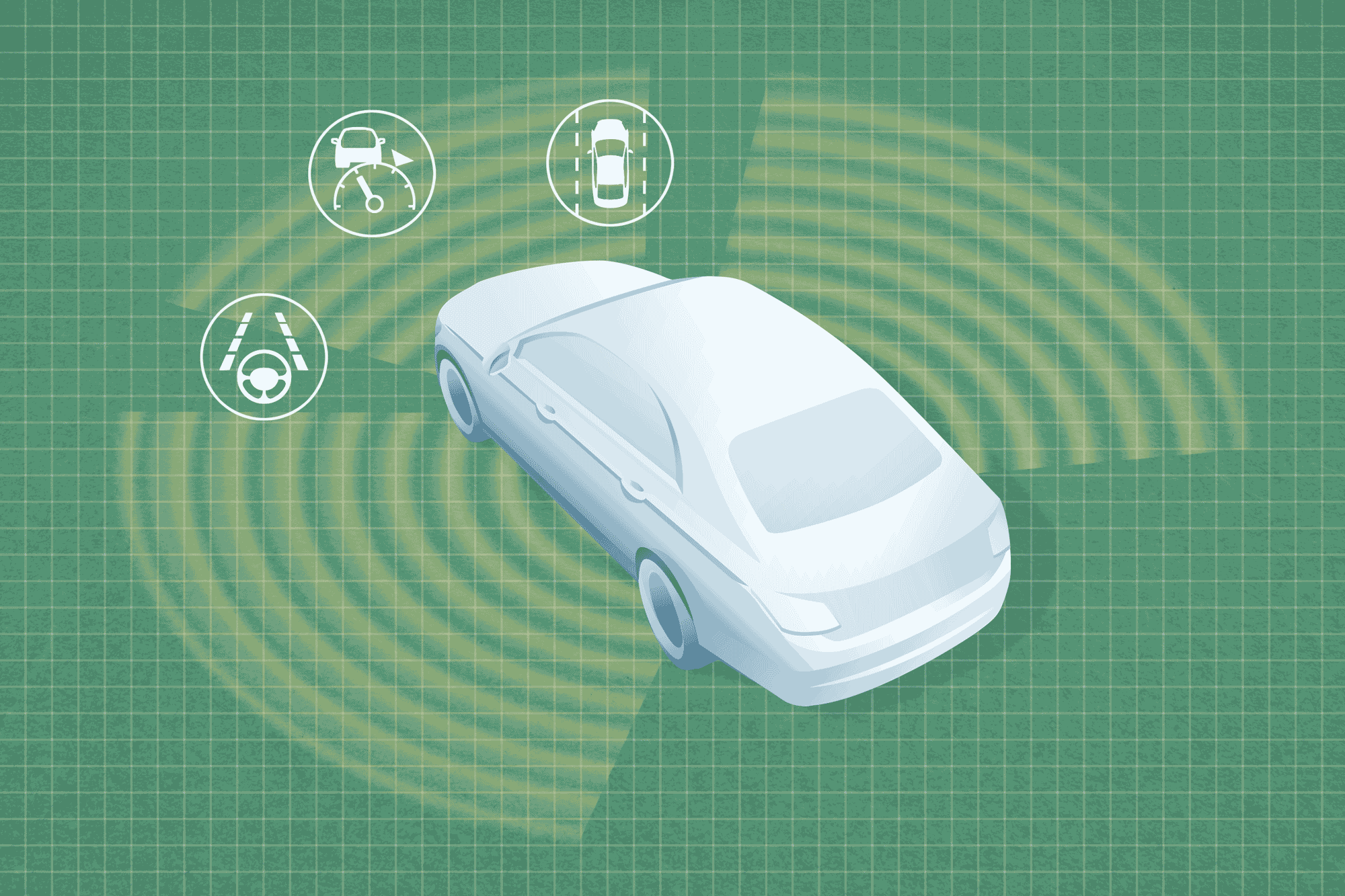What Does ADAS Mean?


ADAS is short for “advanced driver-assistance systems,” an umbrella phrase for a range of vehicle technologies that can warn of danger and even automate some driving functions — including acceleration, braking or steering. Such actions can increase safety and, in some cases, make driving easier.
Related: Which Cars Have Self-Driving Features for 2021?
We tend to notice the added convenience. Some of the features, such as adaptive cruise control, make driving tasks easier and less fatiguing, but the core purpose of these technologies is to increase safety by reducing driver mistakes; after all, the National Highway Traffic Safety Administration reports that 94% of serious crashes come from human error. ADAS technology aims to prevent crashes or, in some cases, mitigate the severity of those that cannot be prevented. Such technology draws data from sensors that can include cameras, radar and ultrasonic tech; some systems also use GPS or mapping data to “see” the road and intended route. ADAS can then alert the driver to hazards and react automatically to mitigate collisions.
The roster of available ADAS technology is expanding as new systems are developed and current ones gain more capability. Together, ADAS features are essential building blocks for full autonomy down the road. Among the most obvious current systems are adaptive cruise control, which can take over acceleration and braking as needed, and lane centering, which steers to keep a vehicle in the center of its lane on straightaways or mild curves. But important ADAS features also include less obvious technology that stays in the background until needed, such as automatic emergency braking. Research by the Insurance Institute for Highway Safety has found that front collision systems with AEB cut the rate of injury-causing rear collisions by as much as 64%.
ADAS features are increasingly optional or standard even in mainstream vehicles, according to a recent study by tech researcher Canalys. It found that 63% of new cars sold in the U.S. in the first half of 2021 included lane-centering systems. But the study also showed that just 10% of the 1 billion cars in use worldwide at the end of 2020 had ADAS features and that it could be 2030 before they are found in half of all cars on the world’s roads.
ADAS Features
Research continues on improved and all-new ADAS technologies, but these are some of the more common ones that you currently might encounter in shopping for a new vehicle. Note that many automakers apply their own brand names to such features or bundles of features, so careful shopping research on system capabilities is needed. Also note that some versions of these features by the same name have more advanced capability than others.
Adaptive Cruise Control
Conventional cruise control that maintains a set speed was one of the first driver-assist technologies and goes back decades, but ACC, its smarter descendant, uses technology like radar and cameras to maintain a safe distance from other vehicles, accelerating to the set speed when safe and braking to slow as traffic demands. The best systems work from highway speeds all the way down to a stop.
Antilock Brake Systems
Another of the earliest electronic safety aids, ABS intervenes to help maintain vehicle control in a panic stop by preventing the driver from locking up the brakes and potentially going into a dangerous skid. ABS is required on new vehicles in the U.S.
Automatic Emergency Braking
These began as front collision warning systems and now have added the capability to activate the brakes if the system determines the driver is not reacting in time to avoid hitting an obstacle. Depending on the vehicle speed, the system might not be able to fully prevent a crash, but it still will provide maximum braking to mitigate the crash and lessen damage and injuries. AEB systems also have gotten more sophisticated in identifying hazards, so some can now identify and intervene to avoid or mitigate collisions with pedestrians, bicycles and even large animals. The best systems function at all speeds.
Automatic High Beams
A sensor allows you to use high beams for better visibility at night but automatically returns to low beams as required to prevent blinding other drivers. Further developments in headlight technology allow some headlights to change direction in response to steering inputs in a curve to direct the beam away from oncoming vehicles and better shape the light beam.
Automatic Parking Assistance
These systems vary in ability, with some only locating a space and aiding steering, while others can fully park the vehicle in parallel or head-in spaces. Some can even get you back out. The most sophisticated versions can do these things without a driver.
Blind Spot Monitor
Blind spot monitors detect vehicles in a driver’s blind spot on either side of the vehicle and alert the driver. Some combine the alert with an active nudge back through steering or selective braking if the driver attempts to move into an occupied lane. More sophisticated units can look farther to the rear to warn of a fast-moving vehicle overtaking in the next lane. Surveys over the years have shown this to be one of the most popular ADAS features.
Driver Monitors
These systems use steering wheel sensors or driver-facing cameras to detect driver inattention. In the case of drowsiness, it will warn the driver; if other ADAS systems such as adaptive cruise control and lane keep assist are activated, it could warn the driver or even shut off those systems.
Electronic Stability Control
Another early system, ESC uses sensors to detect steering wheel position, braking and the vehicle’s intended direction of travel. It will automatically intervene with selective braking to improve stability and prevent loss of control (spinouts or rollovers) in emergency swerves or other situations in which the driver might overreact in trying to steer the vehicle. ESC also is required on new vehicles in the U.S.
Lane-Centering Steering
This technology — also called lane-keeping assist, though there can be subtle differences in capability when it comes to how — actively steers the vehicle to keep it in its lane. It requires visible lane markings to function and can be impaired by bad weather, construction zones or worn lane lines. Some more advanced lane-centering steering systems may incorporate the ability to change lanes on command.
Lane Departure Warning
This lower-level lane technology also identifies lane markings (with similar limitations as lane centering) and alerts the driver if the vehicle begins to drift out of its lane without activating a turn signal. The alert may be visual, a sound or even a vibration of the steering wheel or seat. More advanced lane departure systems (also called lane-keeping assist) incorporate the ability to make a slight steering or brake correction to nudge the vehicle back into its lane but fall short of centering the vehicle in the lane.
Head-Up Display
This technology can display information such as speed, speed limits and navigation directions at eye level in the windshield so drivers can keep their eyes directed at the road ahead. Some systems are less visible or disappear from view entirely if the driver is wearing eyewear with polarized lenses, however.
Navigation
While some people might not think of GPS navigation systems as an ADAS, they can help drivers keep their attention on the road and, in some cases, be in the correct lane for turns, splits or exits. Some also identify speed limits and warn of upcoming traffic and hazards in real time. Navigation also is one ADAS feature that can be added after the purchase of a car through smartphone integration or with accessories.
Rear Cross-Traffic Alert
This uses sensors to detect vehicle, pedestrian or other traffic approaching the vehicle from either side in the rear in low-speed situations, such as parking lots. Some just alert the driver; others now are capable of automatic emergency braking if the driver does not react.
Video Rearview “Mirror”
Building on backup cameras (now legally required) and 360-degree camera systems that can reveal hazards all around the vehicle in tight spaces, video rearview “mirrors” use a rear camera to offer a widescreen view of the road behind a vehicle unobstructed by limits to visibility within the vehicle. Similar systems for side-view mirrors have been developed but do not yet have regulatory approval in the U.S.
More From Cars.com:
- Which Cars Have Autopilot?
- What Is Automatic Emergency Braking?
- What Is Lane Keep Assist?
- More Safety Coverage
What ADAS Does Not Mean
The key word in “advanced driver-assistance systems” is assistance. Current ADAS technology does not allow fully autonomous driving — not yet, anyway, and maybe not for a long time. You’re still the driver and ultimately responsible for safe operation. Forget automakers’ marketing labels such as Autopilot or Co-Pilot or ProPilot or others — you are the pilot.
That’s true even for the most advanced current systems that allow you to have your hands off the wheel in some specific situations. They still qualify as Level 2 automation on the six tiers of autonomous driving capability defined by SAE International, with Level 6 being full self-driving. Level 2 still requires the driver to be paying attention and in charge. The most recent effort to equip a production vehicle for limited Level 3 automation (where the car can take over driving under specific conditions and will alert the driver to take back control when needed) failed. Audi told Automotive News that it gave up on Level 3 aspirations for the latest generation of its Audi A8 luxury sedan after failing to resolve global legal and regulatory issues.
ADAS Worries
A concern with ADAS technology is that it can make drivers lazy or disengaged from driving. To help avoid that, vehicles with the most advanced systems typically also include technology — such as sensors and driver-facing cameras — that will verify the driver has their eyes on the road and, in most situations, hands on the wheel, otherwise the systems shut down.
These safeguards aren’t perfect, however. Many can be abused on purpose by determined fools, as you can verify with a casual survey of YouTube videos. In August, the magazine Car and Driver tested 17 vehicles with advanced ADAS capability and found that some systems could be tricked into letting the driver sit in the backseat. That’s concerning but thankfully does not seem widespread.
A bigger concern for drivers is that they could be more prone to distraction when ADAS technology is engaged. A recent study by MIT found that when the systems were turned on and assisting with driving, drivers looked away from the road more frequently and for longer durations than when the systems were off. Worrisome longer glances away from the road included looking down (such as at a smartphone or lap) and at the central dashboard touchscreen. The results might not be surprising, but they should be a reminder that drivers need to stay engaged even as they have less to do.
Drivers also need to be aware that bad weather can hamper ADAS performance — and it doesn’t have to be snow or ice. A recent study of ADAS performance by AAA showed significantly degraded reliability in simulated rain. It found that in ideal conditions, no test vehicle with an automatic emergency braking system failed to prevent a city-speed crash — but in rain, 17% of the test runs at 25 mph resulted in a crash and 33% failed at 35 mph. Meanwhile, lane keep assist crossed lane markers 37% of the time in ideal conditions and 69% of the time in rain.
Cars.com’s Editorial department is your source for automotive news and reviews. In line with Cars.com’s long-standing ethics policy, editors and reviewers don’t accept gifts or free trips from automakers. The Editorial department is independent of Cars.com’s advertising, sales and sponsored content departments.

Former D.C. Bureau Chief Fred Meier, who lives every day with Washington gridlock, has an un-American love of small wagons and hatchbacks.
Featured stories




